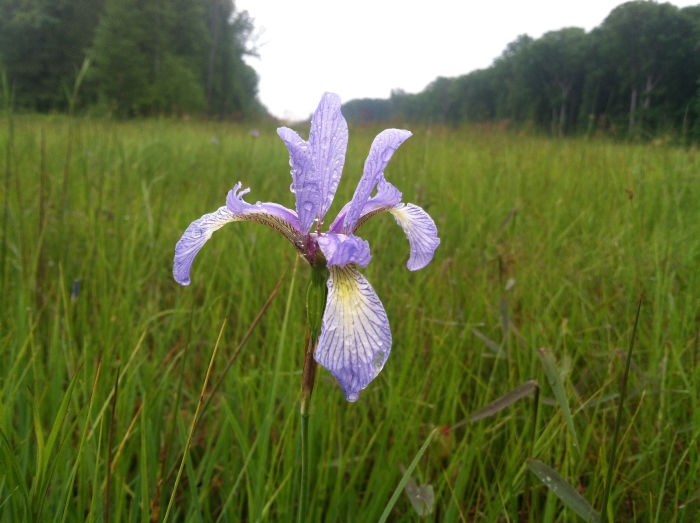Slender Blue Flag
(Iris prismatica)
Slender Blue Flag (Iris prismatica)
/
/

Devin Rodgers and Mason Brock (Masebrock)
Public domain
Image By:
Devin Rodgers and Mason Brock (Masebrock)
Recorded By:
Copyright:
Public domain
Copyright Notice:
Photo by: Devin Rodgers and Mason Brock (Masebrock) | License Type: Public domain | License URL: https://creativecommons.org/public-domain/ | Uploader: Masebrock | Publisher: Wikimedia Commons | Title: Iris_prismatica_Eastern_Highland_Rim.JPG | Notes: {{Location_dec|39.934536|-75.440809}} {{Information |Description=Closeup photograph of a flower of the {{MultiLink|Siberian Iris}} ({{BioLinkSpecies|Iris sibirica}}). Photo taken [[:en:Tyler Arboretum|Tyler Arboretum]] wher




















Estimated Native Range
Summary
Iris prismatica, commonly known as Slender Blue Flag or Cubeseed Iris, is a perennial herb native to wet meadows, marsh edges, and coastal plain wetlands in the eastern United States, from Maine south to Alabama, and extending into the Canadian provinces of Ontario and Nova Scotia. It typically grows to a height of up to 80 cm (31 inches) with flowering stalks bearing long, narrow leaves that can reach 60 cm in length but are rarely more than 5 mm across. The Slender Blue Flag blooms in May, showcasing 2-3 pale blue to blue-violet flowers that are quite showy and attract pollinators.
This species is valued for its ornamental flowers and its ability to thrive in wet conditions, making it suitable for water gardens, rain gardens, and naturalized areas. It is also used for shoreline stabilization and habitat restoration. Iris prismatica is cold hardy to USDA Zone 3, indicating its resilience to cold temperatures. Gardeners should provide full sun to part shade and ensure the soil is consistently moist with slow to medium drainage. While it is adaptable to various soil types, it prefers acidic conditions. Despite its beauty, it is important to note that this iris can be susceptible to iris borer and fungal leaf spot. Additionally, it is listed as threatened or endangered in several states, which underscores the importance of responsible cultivation and conservation efforts.CC BY-SA 4.0
This species is valued for its ornamental flowers and its ability to thrive in wet conditions, making it suitable for water gardens, rain gardens, and naturalized areas. It is also used for shoreline stabilization and habitat restoration. Iris prismatica is cold hardy to USDA Zone 3, indicating its resilience to cold temperatures. Gardeners should provide full sun to part shade and ensure the soil is consistently moist with slow to medium drainage. While it is adaptable to various soil types, it prefers acidic conditions. Despite its beauty, it is important to note that this iris can be susceptible to iris borer and fungal leaf spot. Additionally, it is listed as threatened or endangered in several states, which underscores the importance of responsible cultivation and conservation efforts.CC BY-SA 4.0
Plant Description
- Plant Type: Herb
- Height: 0.5-2 feet
- Width: 0.3-1 feet
- Growth Rate: Moderate, Rapid
- Flower Color: Blue, Purple
- Flowering Season: Spring, Summer
- Leaf Retention: Semi-Deciduous
Growth Requirements
- Sun: Full Sun, Part Shade
- Water: Medium, High
- Drainage: Slow, Medium
Common Uses
Bee Garden, Bird Garden, Butterfly Garden, Deer Resistant, Hummingbird Garden, Low Maintenance, Potted Plant, Rabbit Resistant, Rock Garden, Showy Flowers, Water Garden
Natural Habitat
Wet meadows, marsh edges, and coastal plain wetlands
Other Names
Common Names: Slender Blue Iris, Cubeseed Iris, Iris Prismatique
Scientific Names: , Iris prismatica, Iris prismatica var. austrina, Iris gracilis, Iris prismatica var. prismatica, Iris sibirica var. trigonocarpa, Iris trigonocarpa, Limniris prismatica,
GBIF Accepted Name: Iris prismatica Pursh